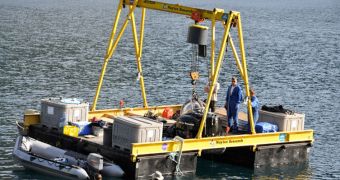Scientists and astronauts with the American space agency are now getting ready to begin work on the Pavilion Lake Research Project (PLRP) 2011. During this year's studies, they will be conducting research under the surface of Kelly Lake, in British Columbia, Canada.
This will be the first comprehensive underwater study that experts conduct with help from NASA mission planners. It will also mark the first time that researchers move out of Pavilion Lake, and into the nearby Kelly Lake.
The goal of the PLRP, in general, is to investigated underwater formations known among experts as microbialites. They are believed to have been produced by tiny microorganisms that existed in abundance on Earth during the planet's earliest days.
At this time, they can only be found in small numbers at several locations around the world. Pavilion Lake contains a vast number of microbialites, experts say, whereas Kelly Lake only has a limited number of the structures.
Vancouver, British Columbia-based Nuytco Researchbuilt and manages the pair of DeepWorker mini-submersibles that researchers will be using to investigate the lake. The environment through which these machines will be traveling is very dangerous.
In order to ensure the maximum scientific return possible under the circumstances, experts turned to mission planners at the NASA Ames Research Center (ARC) for assistance. The Human-Computer Interaction Group here has planning software unlike any other in existence today.
The HCIG used its advanced task-planning tools to create a mission path for the NASA Mars Exploration Rovers (MER) Spirit and Opportunity. The latter is still roving the surface of the Red Planet, more than seven years after its deployment.
“As a group, we’ve been interested in the analogs for a while, essentially as test beds for future tool development,” explains the leader of the software-development group, Mike McCurdy. Analogs is the generic name given to places that resemble other worlds.
Data collected by the PLRP team could come in very handy when planning or executing a mission to the Red Planet, for example. But, in order for the studies to be of any help, they need to be extensive and thorough, investigators explain.
“I think that [PLRP] is very applicable to future missions, because it’s the same idea. It’s putting a crew in a rover, equipping them with what they need to go and do,” explains NASA Johnson Space Center (JSC) mission planner Lauren Rush, quoted by Daily Galaxy.
“These unique and rare microbialite formations are important to NASA's astrobiology effort because they are big, macroscopic evidence of microscopic life,” NASA Astrobiology Institute expert Dr. Chris McKay said back in 1998, when the agency had just begun exploring the lake.
“They are helping us understand one of the big astrobiology questions how early life took hold and began to flourish on Earth. These fossils are like seeing a billion-year-old footprint in the sand and comparing it to a modern human foot,” he explained.

 14 DAY TRIAL //
14 DAY TRIAL //